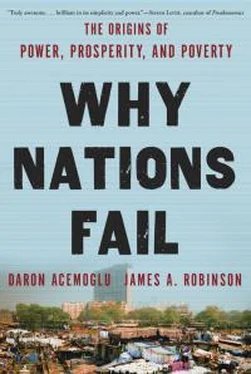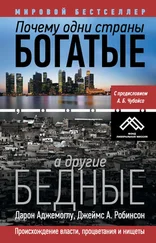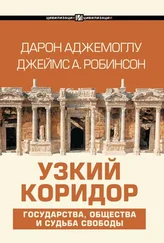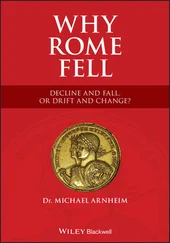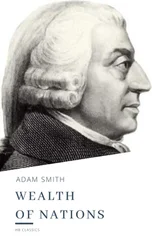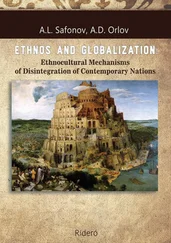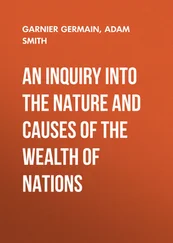The roots of the economic institutions of Kongolese society flowed from the distribution of political power in society and thus from the nature of political institutions. There was nothing to stop the king from taking people’s possessions or bodies, other than the threat of revolt. Though this threat was real, it was not enough to make people or their wealth secure. The political institutions of Kongo were truly absolutist, making the king and the elite subject to essentially no constraints, and it gave no say to the citizens in the way their society was organized.
Of course, it is not difficult to see that the political institutions of Kongo contrast sharply with inclusive political institutions where power is constrained and broadly distributed. The absolutist institutions of Kongo were kept in place by the army. The king had a standing army of five thousand troops in the mid-seventeenth century, with a core of five hundred musketeers—a formidable force for its time. Why the king and the aristocracy so eagerly adopted European firearms is thus easy to understand.
There was no chance of sustained economic growth under this set of economic institutions and even incentives for generating temporary growth were highly limited. Reforming economic institutions to improve individual property rights would have made the Kongolese society at large more prosperous. But it is unlikely that the elite would have benefited from this wider prosperity. First, such reforms would have made the elite economic losers, by undermining the wealth that the slave trade and slave plantations brought them. Second, such reforms would have been possible only if the political power of the king and the elite were curtailed. For instance, if the king continued to command his five hundred musketeers, who would have believed an announcement that slavery had been abolished? What would have stopped the king from changing his mind later on? The only real guarantee would have been a change in political institutions so that citizens gained some countervailing political power, giving them some say over taxation or what the musketeers did. But in this case it is dubious that sustaining the consumption and lifestyle of the king and the elite would have been high on their list of priorities. In this scenario, changes that would have created better economic institutions in society would have made the king and aristocracy political as well as economic losers.
The interaction of economic and political institutions five hundred years ago is still relevant for understanding why the modern state of Congo is still miserably poor today. The advent of European rule in this area, and deeper into the basin of the River Congo at the time of the “scramble for Africa” in the late nineteenth century, led to an insecurity of human and property rights even more egregious than that which characterized the precolonial Kongo. In addition, it reproduced the pattern of extractive institutions and political absolutism that empowered and enriched a few at the expense of the masses, though the few now were Belgian colonialists, most notably King Leopold II.
When Congo became independent in 1960, the same pattern of economic institutions, incentives, and performance reproduced itself. These Congolese extractive economic institutions were again supported by highly extractive political institutions. The situation was worsened because European colonialism created a polity, Congo, made up of many different precolonial states and societies that the national state, run from Kinshasa, had little control over. Though President Mobutu used the state to enrich himself and his cronies—for example, through the Zairianization program of 1973, which involved the mass expropriation of foreign economic interests—he presided over a noncentralized state with little authority over much of the country, and had to appeal to foreign assistance to stop the provinces of Katanga and Kasai from seceding in the 1960s. This lack of political centralization, almost to the point of total collapse of the state, is a feature that Congo shares with much of sub-Saharan Africa.
The modern Democratic Republic of Congo remains poor because its citizens still lack the economic institutions that create the basic incentives that make a society prosperous. It is not geography, culture, or the ignorance of its citizens or politicians that keep the Congo poor, but its extractive economic institutions. These are still in place after all these centuries because political power continues to be narrowly concentrated in the hands of an elite who have little incentive to enforce secure property rights for the people, to provide the basic public services that would improve the quality of life, or to encourage economic progress. Rather, their interests are to extract income and sustain their power. They have not used this power to build a centralized state, for to do so would create the same problems of opposition and political challenges that promoting economic growth would. Moreover, as in much of the rest of sub-Saharan Africa, infighting triggered by rival groups attempting to take control of extractive institutions destroyed any tendency for state centralization that might have existed.
The history of the Kingdom of Kongo, and the more recent history of the Congo, vividly illustrates how political institutions determine economic institutions and, through these, the economic incentives and the scope for economic growth. It also illustrates the symbiotic relationship between political absolutism and economic institutions that empower and enrich a few at the expense of many.
GROWTH UNDER EXTRACTIVE POLITICAL INSTITUTIONS
Congo today is an extreme example, with lawlessness and highly insecure property rights. However, in most cases such extremism would not serve the interest of the elite, since it would destroy all economic incentives and generate few resources to be extracted. The central thesis of this book is that economic growth and prosperity are associated with inclusive economic and political institutions, while extractive institutions typically lead to stagnation and poverty. But this implies neither that extractive institutions can never generate growth nor that all extractive institutions are created equal.
There are two distinct but complementary ways in which growth under extractive political institutions can emerge. First, even if economic institutions are extractive, growth is possible when elites can directly allocate resources to high-productivity activities that they themselves control. A prominent example of this type of growth under extractive institutions was the Caribbean Islands between the sixteenth and eighteenth centuries. Most people were slaves, working under gruesome conditions in plantations, living barely above subsistence level. Many died from malnutrition and exhaustion. In Barbados, Cuba, Haiti, and Jamaica in the seventeenth and eighteenth centuries, a small minority, the planter elite, controlled all political power and owned all the assets, including all the slaves. While the majority had no rights, the planter elite’s property and assets were well protected. Despite the extractive economic institutions that savagely exploited the majority of the population, these islands were among the richest places in the world, because they could produce sugar and sell it in world markets. The economy of the islands stagnated only when there was a need to shift to new economic activities, which threatened both the incomes and the political power of the planter elite.
Another example is the economic growth and industrialization of the Soviet Union from the first Five-Year Plan in 1928 until the 1970s. Political and economic institutions were highly extractive, and markets were heavily constrained. Nevertheless, the Soviet Union was able to achieve rapid economic growth because it could use the power of the state to move resources from agriculture, where they were very inefficiently used, into industry.
Читать дальше
